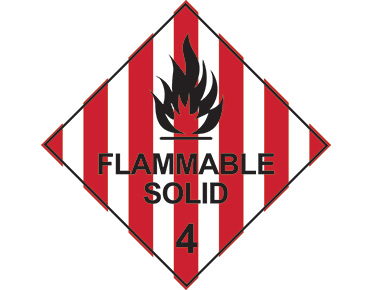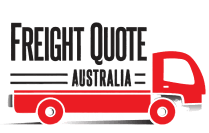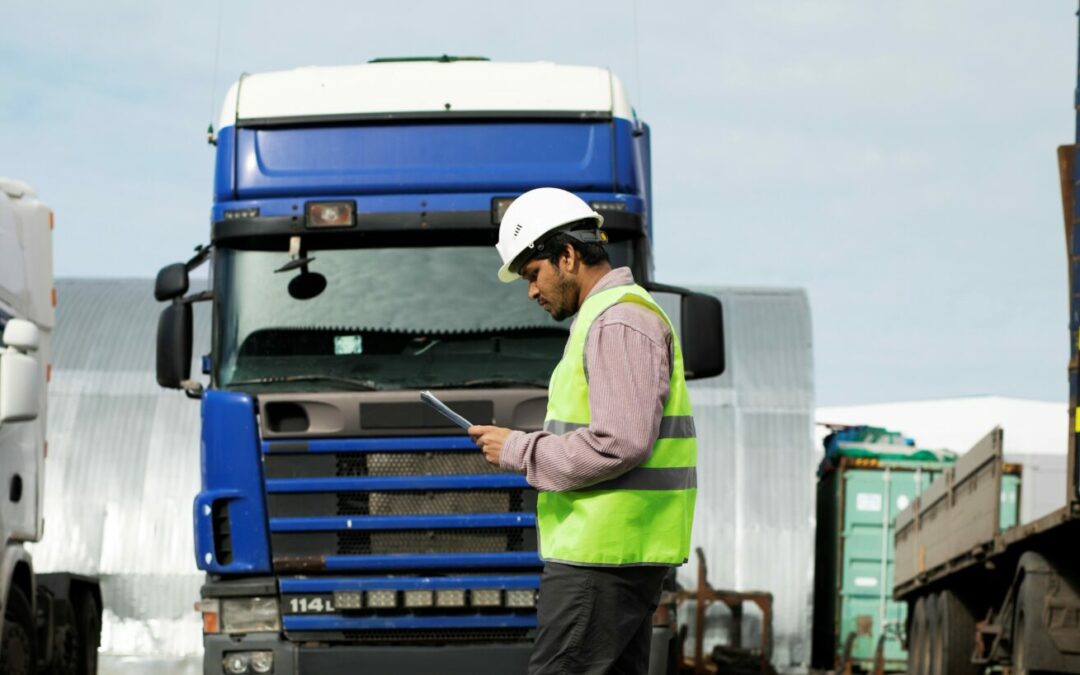Transporting flammable solids in Australia requires careful consideration and adherence to specific guidelines to ensure the safety of both the goods being transported and the people involved. Out of the 9 dangerous goods classes, flammable solids are a part of Class 4. Following is an overview of the regulations for transporting flammable solids in Australia. Logistics professionals, business owners and vehicle operators all have a role to play in transporting flammable solids safely and efficiently.
What Are Flammable Solids?
Flammable solids are substances that have properties that make them highly prone to catching fire and sustaining combustion. Unlike liquids or gases, these materials are in a solid state at normal temperatures and pressures. Flammable solids can ignite and burn when exposed to an ignition source, such as an open flame, spark, or heat.
Flammable solids encompass a wide range of materials. Some common examples of flammable solids are matches and lighters, fireworks, solid fuels (such as charcoal briquettes) and metal powders (like aluminium or magnesium). Certain chemicals, such as powders or granules used in manufacturing processes, can be classified as flammable solids. Some metals, including magnesium and potassium, are also considered flammable solids due to their ability to react vigorously with oxygen in the air, resulting in combustion. Additionally, pyrophoric materials, which can spontaneously ignite upon contact with air, fall under the category of flammable solids.

Matches are flammable solids which are commonly transported by road.
It’s important to understand that flammable solids can vary in their specific characteristics and risks. Some materials may have a higher ignition temperature, meaning they require more heat to catch fire, while others may ignite easily at lower temperatures. Similarly, some flammable solids may burn slowly and steadily, while others may produce intense flames and heat. Different types of flammable solids may necessitate specific precautions, including avoiding moisture contact, ensuring proper ventilation, or utilising specialised containers to prevent reactions or combustion. Understanding the specific nature of the flammable solids you are dealing with is essential for implementing appropriate safety measures, and the appropriate packaging, labelling, storage conditions, and transportation methods.
How to Transport Flammable Solids Safely
Here are the most important precautions to remember when transporting flammable solids in Australia:
Proper Packaging and Labelling
Proper packaging and labelling play a critical role in ensuring the safe transportation of flammable solids. They will help minimise the risk of accidents and ensure that handlers and transportation personnel are aware of the hazards associated with the specific materials.
When packaging flammable solids, choose containers that meet safety standards and are specifically designed for transporting hazardous materials. These containers are specifically engineered to withstand potential risks such as ignition and combustion. They should also be constructed from durable materials that can withstand the transportation, including vibration, impact, and temperature variations.
The packaging should be resistant to damage and leakage to prevent spills or releases during transit. If not contained properly, flammable solids can cause serious fires and harm the environment.
In addition to proper packaging, clear and appropriate labelling is essential for safe transportation. Labels should display hazard warnings, including the proper UN number and hazard class, in accordance with regulatory requirements. The labelling should be accurate, legible, and easily visible on the packaging ensuring that anyone working in the close vicinity of flammable solids knows exactly what’s inside without having to ask or investigate further to find out.

Image courtesy of Global Spill and Safety.
Compliance with Storage and Handling Regulations
Storage areas for flammable solids must be well-ventilated to prevent the accumulation of flammable vapours and maintain air quality. It is crucial to ensure that the storage area is free from potential ignition sources, such as open flames or sparks. Designated storage areas should be designed and equipped to handle flammable solids. This may include fire-resistant construction, appropriate fire suppression systems, and specialised storage containers or cabinets that provide additional protection against fire hazards. Transport depots may or may not provide adequate storage facilities for flammable solids. Check in advance before organising your freight.
Regular inspections of storage facilities are also recommended to ensure ongoing compliance with safety regulations. These inspections help identify any potential hazards or issues that are unsafe. By addressing hazards, such as damaged containers, leaking materials, or improper storage practices, the risk of accidents and incidents will be kept to a minimum.
Adequate Ventilation
If flammable solids are being transported in enclosed spaces such as vehicles or containers, it’s important to take measures to ensure proper airflow. Adequate ventilation is especially important when transporting flammable solids that have the potential to release flammable vapours or gases.
Ensuring proper ventilation will help prevent the build-up of vapours that can lead to fires or explosions. Using ventilation systems or approved containers with venting mechanisms can allow the release of potentially hazardous gases emitted by flammable solids during transportation. As a result, the risk of ignition or explosion is significantly reduced.
Fire Prevention and Being Prepared for Emergencies
To mitigate the risks associated with flammable solids, it’s important to ensure that the vehicle used for transportation is equipped with suitable fire extinguishers. These extinguishers should be specifically designed for extinguishing fires involving flammable solids. Having fire extinguishers accessible inside the vehicle allows for a quick response in case of a fire, hopefully preventing it from spreading and causing further damage.
Whether you’re a business owner or a dangerous goods transporter, ensure you train your workers on fire safety protocols and emergency response procedures. This training should include recognising fire hazards, understanding the behaviour of flammable solids during a fire, and knowing how to effectively respond to different fire scenarios. By having the necessary knowledge and skills, they’ll be better prepared to handle any fire-related incidents that may occur during transportation.
Regular drills and exercises are valuable in retaining knowledge too. Conducting fire drills every few months ensures that everyone is familiar with the proper use of fire safety equipment and other evacuation procedures during an emergency. These drills also help identify any gaps in emergency response plans and provide an opportunity to make adjustments. Although it might cost a business time and effort in the short term, it will save a lot of money in the long term, as risks of damage and injury can be avoided.

Fire extinguishers must be readily accessible at all times.
Transport Route Planning
When planning transport routes, it is important to take into account the specific characteristics of the flammable solids being transported. Consider the road conditions along the route, such as sharp turns, steep inclines or declines, narrow roads, or areas with poor infrastructure. Choosing routes with well-maintained roads and stable infrastructure helps reduce the risk of accidents while on the road.
Regulations for Transporting Flammable Solids
Australia has established a comprehensive legal framework to regulate the transportation of dangerous goods, including flammable solids. Familiarise yourself with the following key regulations and requirements, relevant to your area:
- The Australian Dangerous Goods Code
The ADG Code is a nationally recognised guideline that provides requirements for the safe transport of dangerous goods, including flammable solids. It covers aspects such as classification, packaging, labelling, loading, and unloading procedures. We recommend you stay up-to-date with the latest revisions and amendments to the ADG Code to avoid trouble down the road.
- State and Territory Regulations
In addition to the ADG Code, each Australian state and territory may have additional regulations and requirements specific to the transportation of dangerous goods. These regulations may include licensing requirements, restrictions on transportation routes, and specific documentation obligations. For example, in New South Wales, along with the ADG, the Dangerous Goods (Road and Rail Transport) Regulation 2022 also applies.
Please note that this is not an exaustive list of regulations you should know for transporting flammable solids, but rather the main framework.
How to Transport Flammable Solids in Australia
Transporting flammable solids in New South Wales, and all throughout Australia, requires a comprehensive understanding of safety protocols, compliance with regulations, and careful planning. Prioritise safety at all times, and stay informed about any updates or changes to regulations to make sure you’re operating legally. Remember, the safe transport of flammable solids is not just a legal obligation but also a moral responsibility to protect lives and the environment.
Need to Transport Class 4 Dangerous Goods in Australia?
There are strict limitations and guidelines to what, and how much of a dangerous material can be transported by a dangerous goods courier, so be sure to declare the Dangerous Goods when requesting a quote online. Are you looking for a flammable solids transport company? Freight Quote Australia is able to arrange transport of most Dangerous Goods, however, we will require the UN number, Class, Packing Group, and Weight of the goods in order to quote and book your freight.
This information is general in nature and we accept no responsibility for consequences arising from the use or reliance on this article. If you need assistance transporting flammable solids, please feel free to submit a Quote Request.

